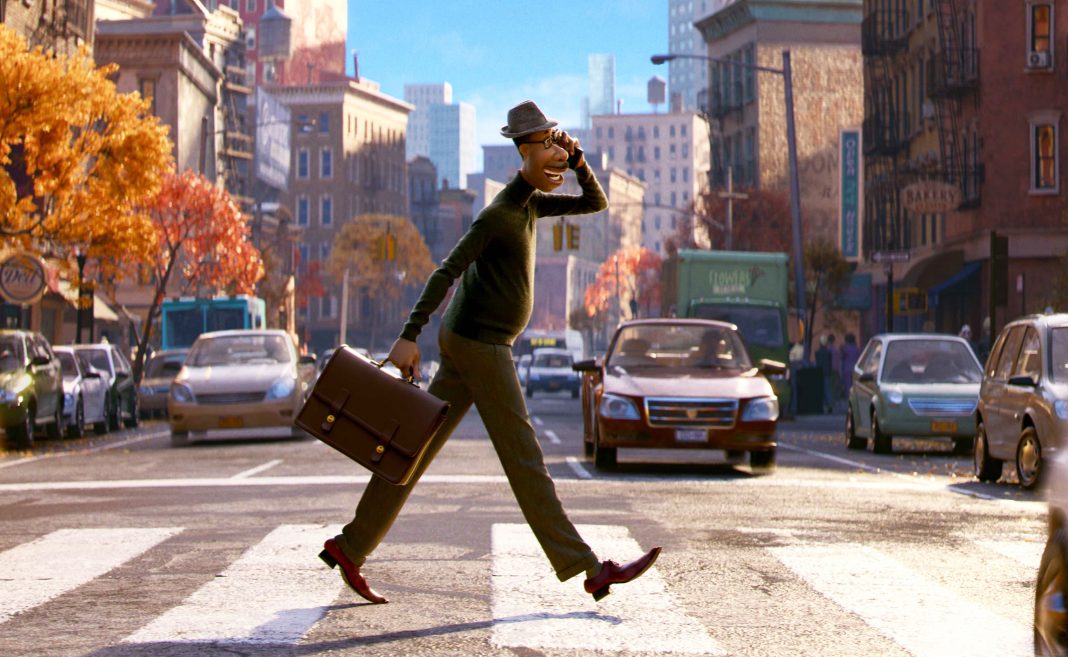In its newest animated feature Soul, Pixar once again invites us into a universe filled with otherworldly characters and magical settings. This beautiful jazz-infused story took almost six years to create, with its production finishing at the first peak of the pandemic. After twenty-three films and sixteen academy awards, critics had high expectations for the newest Pixar animation—and the studio did not disappoint.
Soul follows the life of a struggling middle-aged jazz musician, Joe Gardner (Jamie Foxx), and his desire for success. After getting his big break with a famous jazz quartet, Joe falls into a sewer hole, sending his soul into the “Great Beyond.” Fighting to get back to his body, Joe meets an impatient young soul named 22 at the You Seminar, an ethereal place that helps newborn spirits find their passion before they’re born on Earth. Since 22 has no interest in becoming human, she offers Joe her Earth patch, and in exchange she gets to stay in her current realm—until something goes very wrong. Through a series of complicated events, the pair explores their own individual souls, and Joe discovers the real purpose of living.
While exploring the Great Beyond and Earth, we witness the insecurities of both characters. We see 22 believing she isn’t good enough to be human, proving it difficult for any mentor to help complete her Earth patch. Her fears and anxieties parallel the familiar fears and anxieties that humans feel as they grow up and experience new things. Joe encounters his own fears as he reflects on his past, reminiscing how little he had accomplished in the jazz world. The contrasting concern between the two souls is profound; one who fears to live, and the other who fears they have not lived enough.
To realistically capture these characters and their journeys, the director of Soul, Pete Docter, along with an incredibly talented team, utilized a unique animation technique never seen in a Pixar film. With the aid of scientific insights and religious perspectives, the animators drew inspiration from a physical element called aerogel. We see Joe, along with other character’s souls, resemble this element as they appear light and airy. It’s a creative take on how our physical spirit might manifest in the space between life and death. Other ethereal characters look like moving Picasso-esque 2D shapes, creating a unique animated world. Throughout the film, as characters fall into different abstract dimensions, this intangible and innovative animation style come to life.
Meanwhile, the film’s score plays a complementary note to the animation. As we follow the emotional journey of Joe and 22, the celestial jazz music raises the story to another dimension. Jon Batiste wrote the composition, along with the help of Trent Reznor and Atticus Ross. As we see in the film, when Joe plays piano, he drifts into a magical trance. Due to the moving score, so does the audience. Songs like “Space Maker,” where the instruments’ sounds feed off one another, heightening the entrancing the beauty of jazz music.
While Pixar usually gears toward a younger audience, Soul proves itself otherwise. The film successfully demonstrates the struggles of being an adult, and the complicated feelings that come with achieving your “dream.” It targets the not-so-simple question: how do you know when your purpose is fulfilled? Pete Docter answers this by reminding us of the simple things in life, such as laughing with your friends, savouring a delicious pizza, or admiring the sunrise. Passion, purpose, or urgency for life doesn’t come from specific accomplishments or being famous. Soul teaches us that simply being a breathing human, living in this world, and loving those around us, is a strong enough purpose.




Beautifully done Reese!
We are all so proud of you.